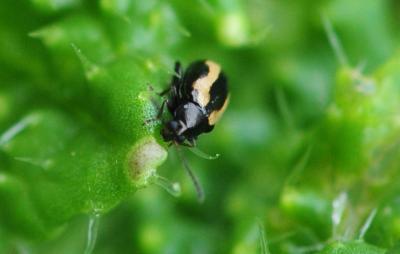Almost all herbivorous insects are specialized to feed on specific host plants and have adapted to their chemical defenses. Flea beetles are important pests of cabbage and other cruciferous plants, such as mustard, horseradish and rapeseed. These plants use a sophisticated defense system, known as the mustard oil bomb, to get rid of their enemies : If plant tissues are wounded, glucosinolates and an enzyme known as myrosinase come into contact, and, as a result, toxic metabolites are formed which deter most insects. This defensive mechanism, however, has no negative effect on flea beetles, according to scientists from the Max Planck Institute for Chemical Ecology in Jena, Germany. Flea beetles are even able to sequester glucosinolates without the mustard oil bomb being set off by the plant's enzyme. Moreover, the insects use their own myrosinase and can utilize the plants' defensive chemicals for their own purposes. The beetles' mustard oil bomb is likely to fend off predators. (Proceedings of the National Academy of Sciences of the USA, May 2014, doi: 10.1073/pnas.1321781111)
Plants defend themselves against herbivores by employing a large arsenal of chemical substances, so-called secondary metabolites. In return, many insects have counter-adapted to plant defenses and can feed on their host plants without any problems. The "arms race" between plants and insects is behind the amazing variety of different species; variations emerged in the course of co-evolution of those two major groups of organisms. Some insects − leaf beetles or tobacco hornworms, for example − even utilize plant metabolites for their own defenses.
Franziska Beran, head of the research group "Sequestration and Detoxification in Insects" at the Max Planck Institute for Chemical Ecology in Jena, Germany, and her colleagues study flea beetles (Phyllotreta). The small pest insects, whose name refers to their impressive jumping ability, prefer to feed on the young leaves of all cabbage species and their method of feeding causes a characteristic pitting damage. They are despised by gardeners and farmers. Before she started working on her PhD project at the Berlin Humboldt University, the young scientist completed an internship at the AVRDC-The World Vegetable Center in Taiwan, where she first learned about the devastating damage this beetle species causes on cabbage cultures in Southeast Asia. Her PhD thesis focused on how the insects aggregate and she asked if they use pheromones and plant odors as olfactory cues. She found out that male flea beetles emit a pheromone that attracts conspecifics; however, the attraction occurs only in conjunction with plant volatiles. At the core of her analyses were the degradation products of glucosinolates, plant metabolites that are responsible for the all-too-familiar smell of cabbage.

A striped flea beetle (Phyllotreta striolata) is feeding on celery cabbage leaves (Brassica rapa). The pest insect causes major damage on young cruciferous plants.
(Photo Credit: © Christian Ulrichs, Humboldt-Universität zu Berlin)
For their current project, the scientists compared glucosinolates in the host plants to the volatile degradation products that are formed when beetles feed on the plants, damaging plant tissues. The plant defense mechanism − called the mustard oil bomb because the degradation products that are formed are toxic − consists of two components: the glucosinolate and the activating enzyme myrosinase. Usually, the glucosinolate-myrosinase system is a highly efficient defense strategy cabbage plants deploy to deter herbivores. However, it does not repel the flea beetles, which readily infest the plants. Analyses showed that volatile degradation products were present when plants were infested with flea beetles, but the substances were not emitted by the plants. It appeared that the flea beetles themselves were emitting the volatile glucosinolate metabolites. Further experiments revealed that flea beetles can take up and store an amount of glucosinolates equivalent to almost 2% of their own body weight. Although cabbage plants contain a large variety of different glucosinolates, the beetles sequester only some of them. Franziska Beran made a surprising conclusion: "The beetles have evolved their own activating myrosinase which specifically hydrolyzes the glucosinolates which they have sequestered from the plants."
The research results indicate that flea beetles not only survive the cabbage plants' mustard oil bomb unscathed, the insects even utilize selectively sequestered glucosinolates for their own purposes. Aphids are known to deploy a similar strategy. However, unlike aphids, which suck the phloem by tapping individual plant cells, flea beetles are chewing insects that wound leaf tissues. Such wounding should activate the mustard oil bomb but does not. Why this is the case and why flea beetles are able to sequester intact glucosinolates is still a mystery. Somehow the insects manage to inactivate the plant's myrosinase. The researchers want to find out where the beetles store the glucosinolates, how they control their own mustard oil bomb, and why they can hydrolyze glucosinolates without being poisoned by the resulting degradation products. Particularly interesting is the question: Why do the insects sequester glucosinolates and how do they control glucosinolate hydrolysis with their own enzyme? "On the one hand, either the glucosinolates or their degradation products may play an important role in the beetles' communication with conspecifics. On the other hand, they may have a specific function in the insects' defense against their own enemies," Franziska Beran hypothesizes. She also wonders about the beetle larvae which live underground and feed on roots. They are exposed to many predators and pathogens and a good chemical defense is definitely advantageous.
Behavioral studies will now also be used in order to elucidate the ecological function of glucosinolate sequestration in flea beetles. Better understanding of insect adaptation to plant chemical defenses will likely contribute to better control of mass occurrences of agricultural pests that are a major problem worldwide. [AO/FB]